Sun 20 Sep 2009
A 1001 MIDNIGHTS review: DASHIELL HAMMETT – The Maltese Falcon.
Posted by Steve under 1001 Midnights , Pulp Fiction , Reviews[6] Comments
by Bill Pronzini:
DASHIELL HAMMETT – The Maltese Falcon. Alfred A. Knopf, hardcover, 1929. Serialized in Black Mask magazine, September 1929 through January 1930. Reprinted many times, in both hardcover and soft, including Pocket #268, July 1944; 8th printing, October 1945, with dust jacket (both shown). Film: Warner Bros., 1931; also released as Dangerous Female. Also: Warner Bros., 1936, as Satan Met a Lady. Also: Warner Bros., 1941.
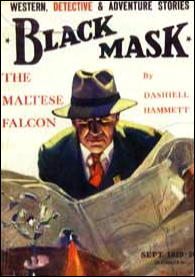
The Maltese Falcon is the prototype hard-boiled private-eye novel, the finest ever written. It is also the most famous of all American detective stories, thanks in no small part to John Huston’s definitive 1941 screen version.
Huston remained remarkably faithful to the novel, using most of Hammett’s original dialogue; and his casting was superb: Humphrey Bogart as Sam Spade; Mary Astor as Brigid 0’Shaughnessy; Sydney Greenstreet as Caspar Gutman; Peter Lorre as Joel Cairo; and Elisha Cook, Jr., as the little gunsel, Wilmer.
(An interesting footnote is that Wamer Brothers originally wanted either Edward G. Robinson or George Raft for the lead role; it was only after both of those actors turned it down that Bogart — Huston’s choice from the first — was selected. The thought of either Robinson or Raft, fine actors though they were, portraying Spade is mind-boggling.)
Sam Spade is likewise the quintessential tough detective. Other writers have altered his image, refined it; but the fact remains that without Spade, there would have been no Philip Marlowe, no Lew Archer, no uniquely American subgenre of detective fiction that has so captured the imaginations of millions that it has been elevated to the status of myth.
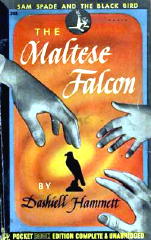
Spade himself is a mythical figure, of course, owing in part to the fact that he is both enigmatic and misunderstood. Otherwise a Hammett admirer, Somerset Maugham called Spade “a nasty bit of goods … an unscrupulous rogue and heartless crook,” and said that “there is little to choose between him and the criminals he is dealing with.”
Maugham missed the point completely. Spade is indeed a nasty bit of goods, an unscrupulous rogue and heartless crook — on the surface. That is his public persona, one he wears like a suit of old clothes or the gun he sometimes needs to carry.
As he says to Brigid at the end of both novel and film, words identical in both: “Don’t be too sure I’m as crooked as I’m supposed to be. That kind of reputation might be good business — bringing in high-priced jobs and making it easier to deal with the enemy.”
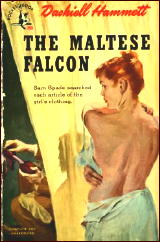
Spade is hardly a saint; but in his own way, and despite his affair with his partner’s wife, about which much has been made, he is an exceedingly moral man.
Similarly, don’t be too sure The Maltese Falcon is everything it seems to be on the surface. It is hard-boiled, yes. Uncompromising, yes. Grim and brutal and even nasty in places, yes. But in its own way, it, too, is exceedingly moral.
The plot of Falcon is familiar to nearly every detective story fan and film buff. Briefly, Spade is visited by a woman calling herself Miss Wonderly; she tells him her sister ran away from New York with a man named Floyd Thursby, that the three have a date that night, and that she wants Spade to rescue the sister.
Enter Miles Archer, Spade’s partner, who says he’ll attend to the job himself. Which he does, but not very well: He gets himself shot to death in a back alley. Also shot that foggy San Francisco night is Floyd Thursby, in front of his hotel.
Spade tracks down Miss Wonderly (in reality Brigid O’Shaughnessy); she tells him a different story and begs for his help, and he agrees.
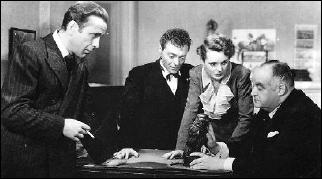
Enter Joel Cairo, who puts a gun on Spade in Spade’s office and first mentions “the black figure of a bird.”
Enter Caspar Gutman, who eventually explains that the figure is “a glorious golden falcon encrusted from head to foot with the finest jewels,” a gift to Emperor Charles V from the Order of the Hospital of St. John of Jerusalem, crusaders who persuaded the emperor to give them the islands of Malta, Gozo, and Tripoli in 1530.
While en route to Spain, the falcon was stolen by the pirate Barbarossa, and over the centuries it passed through various private hands, two of those hands being Gutman’ s — almost.
He has spent seventeen years tracking down the black bird, almost got it in Paris, almost got it in Constantinople: wants it desperately. So do Joel Cairo and Brigid O’Shaughnessy, both of whom were confederates of Gutman’s at one time and both of whom have tried to double-cross him to get it for themselves.
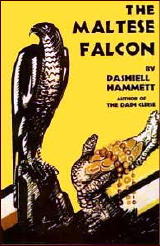
Another murder and more double-dealing lead to a grand finale in Spade’s flat with all the principals present — including the falcon, which has just arrived via the ship La Paloma from Hong Kong. Or has it? The confrontation between Spade and the murderer of Miles Archer remains one of the most powerful in all of crime fiction.
The Maltese Falcon is hardly a perfect novel; such is a rara avis indeed, almost as rare as the Maltese falcon itself. Spade’s affair with Iva Archer is never satisfactorily resolved. The character of Rhea Gutman, Gutman’s daughter, seems superfluous. (John Houston thought so, too: He excised her completely from his screen version.)
Bits and pieces don’t quite hang together or are fused by melodrama. But this is nitpicking, really. In all ways that matter, it is truly a classic work, summed up brilliantly by Houston in the last line of the film, when he had Bogart/Spade say that the Maltese falcon is “the stuff that dreams are made of.”
———
Reprinted with permission from 1001 Midnights, edited by Bill Pronzini & Marcia Muller and published by The Battered Silicon Dispatch Box, 2007. Copyright © 1986, 2007 by the Pronzini-Muller Family Trust.
September 20th, 2009 at 3:36 pm
Beneath the tough cynical surface of the novel is a romantic and even melodramtic story that would have been perfectly at home in a book by Sax Rohmer. What Hammett does here, and in many of his other works, is to simply tell the story in a manner that gives us an almost matter of fact look at the stuff of romance and dreams. I’ve always wondered to what extent he was influenced by writers like Stephen Crane and Joseph Conrad who took a similar tack with the adventure story. Certainly Hammett’s own story of the South Seas was influenced by Conrad.
Spade is am amalgram of the elements that Hammett thought would make the perfect private detective, but I think there is a recognition there that what would make a man a perfect private detective wouldn’t mean he was a perfect man.
Hammett clearly admires Spade, but I think he also feels a little for him. I’ve always thought the famous Flitcraft story was as much about Spade’s inability to escape himself as it was a warning to Brigid. For me the affair with Iva Archer is just another recognition that Spade can’t escape his nature, even when he wants to.
In one sense The Maltese Falcon is almost a classical tragedy, with Spade a hero who can out wit and escape anything but his own fatal hubris.
September 20th, 2009 at 5:36 pm
In regard to the 1931 pre code film version of the book it would likely be a classic itself if not for the definitive John Huston/Bogart film a decade later. There is quite a bit to admire in the 1931 version including Ricardo Cortez version of Spade, and a pretty racy version of the scene where he makes Brigid strip. The little coda at the end when Spade visits Brigid in jail is even more cynical than Hammett in some ways.
Of course it’s not a shade on the Huston film, but well worth seeing, whereas Satan Met a Lady probably is only watchable in the way you watch a train wreck, you just can’t believe how bad it really is until you see it for yourself.
September 21st, 2009 at 2:58 pm
I’ve always been impressed by the economy of motion in the book; it simmers with exotic scents, foreign intrigue, international adventure, yet most of the action takes place in three rooms in ‘Frisco. With very little work it could be done as a stage play!
September 21st, 2009 at 4:11 pm
Back when I was teaching a course in the appreciation of detective fiction at St. Olaf College (at which no less a person than Fred Dannay wondered how I managed to get away with it — and I still wonder), I often used The Maltese Falcon as a text. I ususally used my copy in the Modern Library edition in the discussions because it had an introduction written by Hammett in 1934 in which he identified the originals of many of the characters. I bought my copy at a used bookstore near the University of Minnesota campus when I was in library school.
September 21st, 2009 at 4:22 pm
On top of everything else, Falcon includes at least one fair play clue worthy of Agatha Christie. Hammett generates real suspense out of what is really just a variation on the detective drawing all the suspects together to reveal the murderer. It’s the rare hard boiled tale that is also, in it’s own way, a classical mystery.
September 21st, 2009 at 6:15 pm
I’ve mentioned this before in a PulpFest report but the dealer across from me in August 2009 at Columbus, Ohio, sold the five BLACK MASK issues containing The Maltese Falcon. Price was $4000. This is a far cry from the days when first edition collectors had absolutely no interest in the magazine versions, which are really the true first edition.